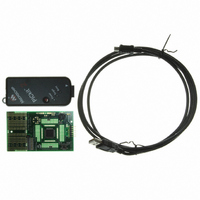DV164121 Microchip Technology, DV164121 Datasheet - Page 16

DV164121
Manufacturer Part Number
DV164121
Description
KIT PICKIT 2 DEBUG EXPRESS
Manufacturer
Microchip Technology
Series
PICkit™ 2r
Type
Microcontrollerr
Specifications of DV164121
Contents
Board, PICkit™ 2 Programmer, Cable, CD
Processor To Be Evaluated
PIC family
Data Bus Width
8 bit, 16 bit, 32 bit
Lead Free Status / RoHS Status
Lead free / RoHS Compliant
For Use With/related Products
PIC Micro® MCU
Lead Free Status / Rohs Status
Lead free / RoHS Compliant
Available stocks
Company
Part Number
Manufacturer
Quantity
Price
Company:
Part Number:
DV164121
Manufacturer:
Microchip Technology
Quantity:
135
Company:
Part Number:
DV164121
Manufacturer:
MICROCHIP
Quantity:
12 000
DS51553E-page 12
• Set OSCCAL – Allows the OSCCAL value to be changed for devices where it is
• Target V
• Calibrate V
• Use V
• Fast Programming – When checked, the PICkit 2 will attempt to program the
• Check Communication – Verifies USB communication with the PICkit 2 and ICSP
• UART Tool… - Puts the PICkit 2 in UART Mode and opens a terminal-like
• Troubleshoot... – Opens a wizard to help with troubleshooting connectivity from
• Download PICkit 2 Programmer Operating System – Performs a download of the
Help
• PICkit 2 User’s Guide – Attempts to launch the user’s guide PDF (Adobe
• 44-Pin Demo Board Guide – Attempts to launch the 44-Pin Demo Board User’s
• LPC Demo Board Guide – Attempts to launch the Low Pin Count Demo Board
• PICkit 2 Programmer on the web – Opens
• Readme – Opens the PICkit 2 Readme.txt file.
• About – Opens a dialog with the PICkit 2 Programmer application version, device
1.4.2
The Device Configuration window displays the device, User ID, Configuration Word
and Checksum. It also displays OSCCAL and Band Gap for parts with those features.
For baseline (12-bit core) devices, serial EEPROM devices, and KeeLoq
devices, you must select the device from the Device drop-down menu.
stored in the last location of Program Memory.
- Auto-Detect – The PICkit 2 will automatically detect whether the target device
- Force PICkit 2 – The PICkit 2 will always attempt to supply V
- Force Target – The PICkit 2 will always assume the target has its own power
ing the PICkit 2 V
assigning a Unit ID to identify between multiple PICkit 2 devices.
and program devices with configurations and code that interferes with the ICSP
signal pins, preventing PICkit 2 from detecting them. Using this feature requires
that the PICkit 2 supplies V
device as fast as possible. When unchecked, the PICkit 2 will slow down ICSP
communication. This may be helpful for targets with loaded ICSP lines.
communication with a target device by attempting to identify the connected device
by its device ID.
interface for communicating with a PIC MCU device program through the USART
pins. See Chapter 7. “PICkit 2 UART Tool” for more information.
the PICkit 2 to the target device. This is most useful where the programmer is
unable to detect the target device at all.
PICkit 2 operating system (firmware).
must be installed).
Guide PDF (Adobe Reader must be installed).
User’s Guide PDF (Adobe Reader must be installed).
default web browser.
file version and firmware version.
has its own power supply or needs to be powered by the programmer on each
operation.
device.
supply.
PP
DD
Device Configuration
First Program Entry – When checked, it allows the PICkit 2 to connect to
DD
Source
& Set Unit ID – Opens a wizard that steps the user through calibrat-
DD
supplied voltage so it is more accurate, and optionally
DD
to the target.
www.microchip.com/pickit2
© 2008 Microchip Technology Inc.
DD
to the target
in the
®
®
HCS
Reader












